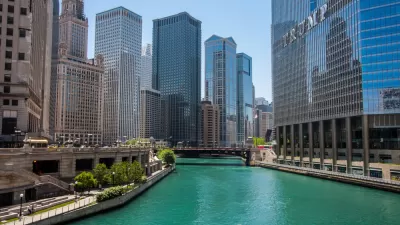Republican frontrunner Donald Trump has announced his plan to expand his branding if elected President of the United States in November.

Citing the quality of his signs and his desire to "piss off" Blair Kamin, the Pultizer Prize winning architecture critic for the Chicago Tribune, Donald Trump announced today that he's having his campaign staff look into opportunities for new locations to place "TRUMP" signs around Washington, D.C. when he's elected.
The idea was born out of a feud between Trump and Kamin, dating back to 2014, when a 2,891-square-foot sign bearing the word "Trump" was attached to the Trump International Hotel and Tower overlooking the Chicago River. In a review for the Tribune, Kamin called the sign "a poke in the eye."
Trump responded to the criticism by calling Kamin a "sucker" and a "bad critic." The whole episode caught the attention of Jon Stewart, while still with the Daily Show, in a segment humorously titled "Signfeud."
"I'm having my staff look at a few new locations for Trump signs in Washington, D.C.," said a noticeably smug Donald Trump to an appreciative audience at a campaign rally in Wisconsin today. "I can't decide if a new sign should go on the façade of the White House or on the North Lawn so it's easier to see in photos from Pennsylvania Avenue," added Trump. The Trump campaign staff released a statement later in the day that also listed the Rose Garden, the Oval Office, Air Force One, Marine One, and the roof of the White House (to be more visible from Marine One), as potential locations for new Trump signage.
FULL STORY: Trump Would Move Infamous Sign From Chicago to the White House If Elected

Maui's Vacation Rental Debate Turns Ugly
Verbal attacks, misinformation campaigns and fistfights plague a high-stakes debate to convert thousands of vacation rentals into long-term housing.

Planetizen Federal Action Tracker
A weekly monitor of how Trump’s orders and actions are impacting planners and planning in America.

Chicago’s Ghost Rails
Just beneath the surface of the modern city lie the remnants of its expansive early 20th-century streetcar system.

Bend, Oregon Zoning Reforms Prioritize Small-Scale Housing
The city altered its zoning code to allow multi-family housing and eliminated parking mandates citywide.

Amtrak Cutting Jobs, Funding to High-Speed Rail
The agency plans to cut 10 percent of its workforce and has confirmed it will not fund new high-speed rail projects.

LA Denies Basic Services to Unhoused Residents
The city has repeatedly failed to respond to requests for trash pickup at encampment sites, and eliminated a program that provided mobile showers and toilets.
Urban Design for Planners 1: Software Tools
This six-course series explores essential urban design concepts using open source software and equips planners with the tools they need to participate fully in the urban design process.
Planning for Universal Design
Learn the tools for implementing Universal Design in planning regulations.
planning NEXT
Appalachian Highlands Housing Partners
Mpact (founded as Rail~Volution)
City of Camden Redevelopment Agency
City of Astoria
City of Portland
City of Laramie



























